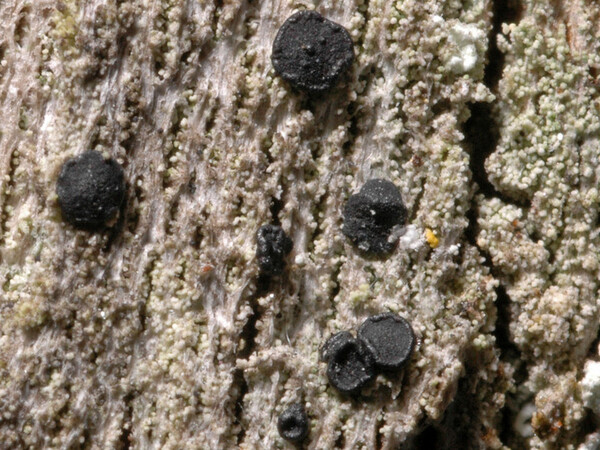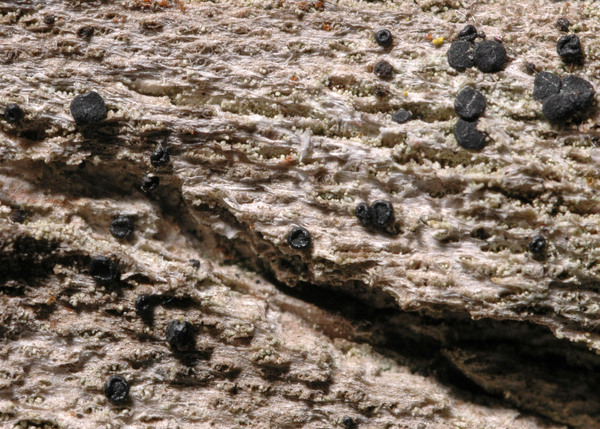Toniniopsis separabilis (Nyl.) Gerasimova & A. Beck
in Gerasimova & al., Lichenologist, 53: 178, 2021. Basionym: Lecidea separabilis Nyl. - Flora, 48: 147, 1865
Synonyms: Bacidia affinis (Stizenb.) Vain.; Bacidia atrosanguinea f. separabilis (Nyl.) Arnold; Bacidia atrosanguinea var. affinis Zw.; Bacidia hegetschweileri (Hepp) Vain. non auct.; Bacidia separabilis (Nyl.) Arnold; Bacidia subincompta auct. (Nyl.) Arnold; Lecidea hegetschweileri Hepp nom.nud.; Lecidea separabilis Nyl.; Toniniopsis subincompta auct. non (Nyl.) Kistenich, Timdal, Bendiksby & S. Ekman
Distribution: N - Frl (Hinteregger 1994), Ven (Nascimbene 2004, 2008c, 2011, Nascimbene & al. 2005b, 2006c, 2013b), TAA (Hinteregger 1994, Nascimbene & al. 2006e, 2009, 2022, Nimis & al. 2015), Lomb, Piem (Isocrono & al. 2004), Emil (Fariselli & al. 2020), Lig (Brunialti & al. 1999). C - Tosc (Benesperi & al. 2007), Abr (Nimis & Tretiach 1999, Caporale & al. 2016), Mol (Garofalo & al. 1999, Caporale & al. 2008, Nimis & Tretiach 1999), Sar (Neuwirth 2018). S - Camp (Garofalo & al. 1999, 2010, Aprile & al. 2003b), Si.
Description: Thallus crustose, episubstratic, grey, grey-green or brown-green, usually consisting of scattered, globose or flattened, 40-100 μm wide granules which often form coralloid, isidia-like outgrowths. Apothecia lecideine, (0.3-)0.4-1(-1.2) mm across, with a purple-brown to black, rarely pink-brown, epruinose, flat to finally convex, sometimes tuberculate disc, and a distinct, paler or darker, finally often excluded proper margin. Proper exciple 59-122 μm wide laterally, without crystals, the inner part red-brown or black-brown, K+ purplish, N+ orange-red, often with a green or blue-green tinge at least in upper part, with a single layer of enlarged cells (up to 8 x 5 μm), the outer rim colourless to pale brown; epithecium greenish to brownish green, scarcely differentiated from the hymenium, K- or K+ purple, N+ purple or orange-red (with or without precipitation of blue crystals); hymenium (45-)55-80(-112) μm high, the lower part colourless except for occasional vertical green streaks, the upper part dirty green to blue-green; paraphyses simple, 1.2-2.4 μm thick at mid-level, the apical cells not swollen or up to 5(-6.5) μm wide; hypothecium dark brown at least in upper part, sometimes with a green-brown tinge, well-separated from the lower part of exciple. Asci 8-spored, clavate, surrounded by a gelatinous I+ blue coat, with a well-developed I+ blue tholus, an I+ darker blue tube and a well-developed ocular chamber, Bacidia-type. Ascospores (3-)5-13-septate, hyaline, bacilliform, clavate or acicular, straight to sigmoid, (13-)20-36(-40) x 2.5-3.5(-4) μm. Pycnidia immersed in thallus. Conidia simple, filiform, curved, 10-20 x c. 0.8 μm. Photobiont chlorococcoid, the cells 5-12 μm in diam. Spot tests: thallus and apothecia K-, C-, KC-, P-, UV-. Chemistry: no lichen substances in thallus; apothecia with Bagliettoana-green in epithecium and rim of exciple; Laurocerasi-brown in hypothecium and lateral part of exciple; sometimes a mixture of the two pigments in exciple. Rubella-orange in epithecium, hypothecium and exciple (in albino morphs).Note: a mainly temperate lichen found on the bark of old broad-leaved trees (especially Fagus and Quercus) in open, humid woodlands. This species was treated as Bacidia subincompta by Coppins & Aptroot (2009) and Toniniopsis subincompta by Kistenich & al. (2018), but Ekman (1996) demonstrated that the type of that species belongs to the lichen presently called Bellicidia incompta. All Italian records are provisionally attributed to T. separabilis, but Italian material urgently needs revision, and should be also compared with the very similar and recently-described T. dissimilis Gerasimova & A. Beck, which is known from Turkey and several European countries, including Austria.
Growth form: Crustose
Substrata: bark
Photobiont: green algae other than Trentepohlia
Reproductive strategy: mainly sexual
Most common in areas with a humid-warm climate (e.g. most of Tyrrenian Italy)
Commonnes-rarity: (info)
Alpine belt: absent
Subalpine belt: very rare
Oromediterranean belt: absent
Montane belt: rare
Submediterranean belt: extremely rare
Padanian area: absent
Humid submediterranean belt: very rare
Humid mediterranean belt: extremely rare
Dry mediterranean belt: absent

Predictive model
Herbarium samples
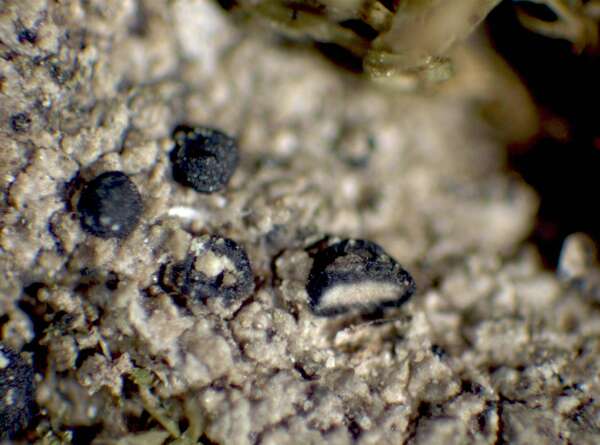

P.L. Nimis; Owner: Department of Life Sciences, University of Trieste
Herbarium: TSB (13320)
2001/11/22
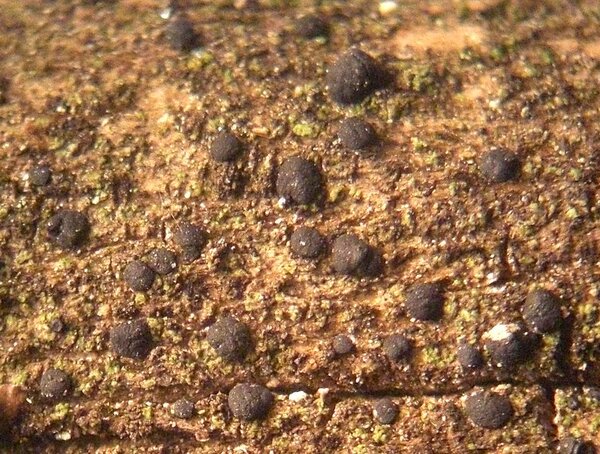

Curtis Randall Björk – CC BY-SA 4.0
British Columbia, Clearwater Valley, Dawson Falls On Pseudotsuga log by river shore, in waterfall spray zone 2012-04-06

Collezione lichenologica Abramo Massalongo del Museo di Storia Naturale G. Ligabue di Venezia - Autori: Seggi, Linda; Trabucco, Raffaella Proprietà: Fondazione Musei Civici di Venezia - CC BY-NC
Italy, Veneto, in op. Tregnago
as Biatora atro-sanguinea
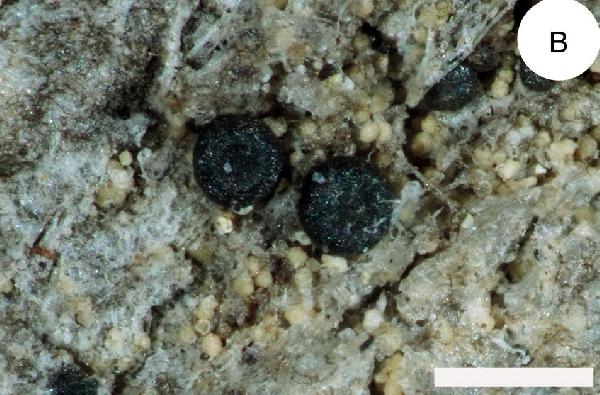
Source: Gerasimova JV, Urbanavichene IN, Urbanavichus GP, Beck A. Morphological and phylogenetic analyses of Toniniopsis subincompta s. lat. (Ramalinaceae, Lecanorales) in Eurasia. The Lichenologist. 2021;53(2):171-183. doi:10.1017/S0024282921000013 - CC BY-NC-ND 4.0
T. separabilis (LE L-15299, JG160); thallus thin, consisting of ±rounded, loose granules. - Scale: 0.5 mm

Source: Gerasimova JV, Urbanavichene IN, Urbanavichus GP, Beck A. Morphological and phylogenetic analyses of Toniniopsis subincompta s. lat. (Ramalinaceae, Lecanorales) in Eurasia. The Lichenologist. 2021;53(2):171-183. doi:10.1017/S0024282921000013 - CC BY-NC-ND 4.0
D, T. separabilis (M-0182613, JG073); thallus thick, wrinkled, forming isidium-like bulges with albino morph apothecia. - Scale: 0.5 mm
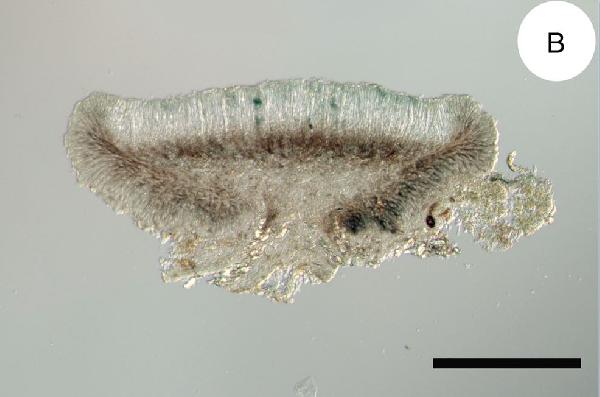
Source: Gerasimova JV, Urbanavichene IN, Urbanavichus GP, Beck A. Morphological and phylogenetic analyses of Toniniopsis subincompta s. lat. (Ramalinaceae, Lecanorales) in Eurasia. The Lichenologist. 2021;53(2):171-183. doi:10.1017/S0024282921000013 - CC BY-NC-ND 4.0
B, lectotype of Lecidea separabilis (H-NYL 17424) - Scale: 200 μm

Source: Gerasimova JV, Urbanavichene IN, Urbanavichus GP, Beck A. Morphological and phylogenetic analyses of Toniniopsis subincompta s. lat. (Ramalinaceae, Lecanorales) in Eurasia. The Lichenologist. 2021;53(2):171-183. doi:10.1017/S0024282921000013 - CC BY-NC-ND 4.0
D, rim and lateral part of exciple with blue coloration along the whole margin (M-0290425, JG145; dark morph) - Scale: 200 μm
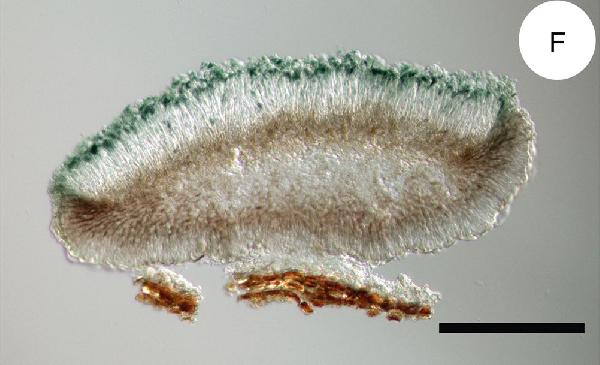
Source: Gerasimova JV, Urbanavichene IN, Urbanavichus GP, Beck A. Morphological and phylogenetic analyses of Toniniopsis subincompta s. lat. (Ramalinaceae, Lecanorales) in Eurasia. The Lichenologist. 2021;53(2):171-183. doi:10.1017/S0024282921000013 - CC BY-NC-ND 4.0
F, dark brown hypothecium with paler exciple below; rim and lateral part of exciple with brown coloration along the whole margin (M-0290437, JG152) - Scale: 200 μm

Source: Gerasimova JV, Urbanavichene IN, Urbanavichus GP, Beck A. Morphological and phylogenetic analyses of Toniniopsis subincompta s. lat. (Ramalinaceae, Lecanorales) in Eurasia. The Lichenologist. 2021;53(2):171-183. doi:10.1017/S0024282921000013 - CC BY-NC-ND 4.0
Exciple structure. B, lectotype of Lecidea separabilis (H-NYL 17424) with paraplectenchymatic exciple structure and one layer of enlarged lumina cells - Scale: 50 μm
Growth form: Crustose
Substrata: bark
Photobiont: green algae other than Trentepohlia
Reproductive strategy: mainly sexual
Most common in areas with a humid-warm climate (e.g. most of Tyrrenian Italy)
Commonnes-rarity: (info)
Alpine belt: absent
Subalpine belt: very rare
Oromediterranean belt: absent
Montane belt: rare
Submediterranean belt: extremely rare
Padanian area: absent
Humid submediterranean belt: very rare
Humid mediterranean belt: extremely rare
Dry mediterranean belt: absent

Predictive model
| Herbarium samples |


P.L. Nimis; Owner: Department of Life Sciences, University of Trieste
Herbarium: TSB (13320)
2001/11/22


Curtis Randall Björk – CC BY-SA 4.0
British Columbia, Clearwater Valley, Dawson Falls On Pseudotsuga log by river shore, in waterfall spray zone 2012-04-06

Collezione lichenologica Abramo Massalongo del Museo di Storia Naturale G. Ligabue di Venezia - Autori: Seggi, Linda; Trabucco, Raffaella Proprietà: Fondazione Musei Civici di Venezia - CC BY-NC
Italy, Veneto, in op. Tregnago
as Biatora atro-sanguinea

Source: Gerasimova JV, Urbanavichene IN, Urbanavichus GP, Beck A. Morphological and phylogenetic analyses of Toniniopsis subincompta s. lat. (Ramalinaceae, Lecanorales) in Eurasia. The Lichenologist. 2021;53(2):171-183. doi:10.1017/S0024282921000013 - CC BY-NC-ND 4.0
T. separabilis (LE L-15299, JG160); thallus thin, consisting of ±rounded, loose granules. - Scale: 0.5 mm

Source: Gerasimova JV, Urbanavichene IN, Urbanavichus GP, Beck A. Morphological and phylogenetic analyses of Toniniopsis subincompta s. lat. (Ramalinaceae, Lecanorales) in Eurasia. The Lichenologist. 2021;53(2):171-183. doi:10.1017/S0024282921000013 - CC BY-NC-ND 4.0
D, T. separabilis (M-0182613, JG073); thallus thick, wrinkled, forming isidium-like bulges with albino morph apothecia. - Scale: 0.5 mm

Source: Gerasimova JV, Urbanavichene IN, Urbanavichus GP, Beck A. Morphological and phylogenetic analyses of Toniniopsis subincompta s. lat. (Ramalinaceae, Lecanorales) in Eurasia. The Lichenologist. 2021;53(2):171-183. doi:10.1017/S0024282921000013 - CC BY-NC-ND 4.0
B, lectotype of Lecidea separabilis (H-NYL 17424) - Scale: 200 μm

Source: Gerasimova JV, Urbanavichene IN, Urbanavichus GP, Beck A. Morphological and phylogenetic analyses of Toniniopsis subincompta s. lat. (Ramalinaceae, Lecanorales) in Eurasia. The Lichenologist. 2021;53(2):171-183. doi:10.1017/S0024282921000013 - CC BY-NC-ND 4.0
D, rim and lateral part of exciple with blue coloration along the whole margin (M-0290425, JG145; dark morph) - Scale: 200 μm

Source: Gerasimova JV, Urbanavichene IN, Urbanavichus GP, Beck A. Morphological and phylogenetic analyses of Toniniopsis subincompta s. lat. (Ramalinaceae, Lecanorales) in Eurasia. The Lichenologist. 2021;53(2):171-183. doi:10.1017/S0024282921000013 - CC BY-NC-ND 4.0
F, dark brown hypothecium with paler exciple below; rim and lateral part of exciple with brown coloration along the whole margin (M-0290437, JG152) - Scale: 200 μm

 INDEX FUNGORUM
INDEX FUNGORUM
 GBIF
GBIF
 DOLICHENS
DOLICHENS

